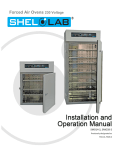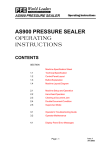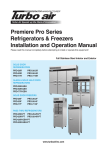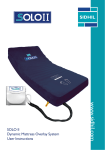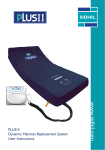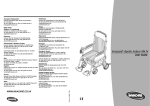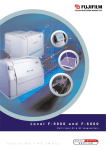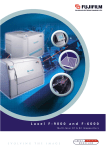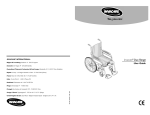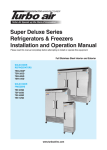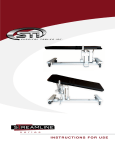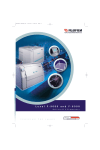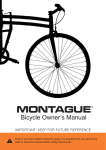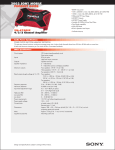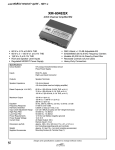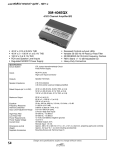Download SMO14-2 SMO28-2
Transcript
SMO Forced Air Ovens 230 Voltage Installation and Operation Manual SMO14-2 SMO28-2 SMO28G-2 Previously Designated: FX14-2 FX28-2 SMO Forced Air Ovens 230 Voltage Previously Designated FX Forced Air Ovens Installation and Operation Manual Part Number (Manual): 4861581 Revision: June 3, 2015 Pictured on Cover: SMO14-2 and SMO28-2 Note: The SMO28G-2 ships with two wire shelves typically used in curing applications. The SMO28G-2 is identical to the SMO28-2 in all other respects. These units are TÜV CUE listed as forced air ovens for professional, industrial, or educational use where the preparation or testing of materials is done at an ambient air pressure range of 22.14 – 31.3 inHg (75 – 106 kPa) and no flammable, volatile, or combustible materials are being heated. These units have been tested to the following requirements: CAN/CSA C22.2 No. 61010-1:2012 CAN/CSA C22.2 No. 61010-2-010 + R:2009 UL 61010A-2-010:2002 UL 61010-1:2012 EN 61010-1:2010 EN 61010-2-010:2003 2|Page TABLE OF CONTENTS INTRODUCTION........................................................................................................................................... 4 General Safety Considerations ................................................................................................................. 4 Engineering Improvements ....................................................................................................................... 5 Contacting Assistance ............................................................................................................................... 5 Temperature Reference Sensor Device ................................................................................................... 5 RECEIVING YOUR UNIT .............................................................................................................................. 6 Inspecting the Shipment ............................................................................................................................ 6 Orientation ................................................................................................................................................. 7 Recording Data Plate Information ........................................................................................................... 10 INSTALLATION .......................................................................................................................................... 11 Location ................................................................................................................................................... 11 Power Source Requirements .................................................................................................................. 11 Power Feed Wiring .................................................................................................................................. 12 Lifting and Handling ................................................................................................................................ 12 Leveling ................................................................................................................................................... 12 Initial Cleaning ......................................................................................................................................... 13 Shelving Installation ................................................................................................................................ 13 GRAPHIC SYMBOLS ................................................................................................................................. 14 CONTROL PANEL OVERVIEW ................................................................................................................. 16 OPERATION ............................................................................................................................................... 18 Operating Precautions ............................................................................................................................ 18 Theory of Operation ................................................................................................................................ 19 Preparing the Oven ................................................................................................................................. 21 Prepare for First Use Burn-In .................................................................................................................. 21 Set the Oven Temperature Set Point ...................................................................................................... 22 Burn-In ..................................................................................................................................................... 23 Temperature Display Accuracy Verification ............................................................................................ 23 Setting the Over Temperature Limit ........................................................................................................ 25 Setting the Timer ..................................................................................................................................... 26 Drying Racks and other Accessories ...................................................................................................... 27 Launch a Heating Profile ......................................................................................................................... 28 USER MAINTENANCE ............................................................................................................................... 29 Cleaning and Disinfecting ....................................................................................................................... 29 Calibrating the Temperature Display....................................................................................................... 30 Door Components ................................................................................................................................... 33 Electrical Components ............................................................................................................................ 33 UNIT SPECIFICATIONS............................................................................................................................. 34 Weight ..................................................................................................................................................... 34 Dimensions .............................................................................................................................................. 34 Capacity .................................................................................................................................................. 34 Shelf Capacity by Weight ........................................................................................................................ 35 Temperature ............................................................................................................................................ 35 Power ...................................................................................................................................................... 35 PARTS LIST ............................................................................................................................................... 36 Ordering .................................................................................................................................................. 36 3|Page INTRODUCTION Thank you for purchasing a Sheldon Manufacturing SMO forced air oven. We know that in today’s competitive marketplace, customers have many choices when it comes to constant temperature equipment. We appreciate you choosing ours. Our continued reputation as a leading laboratory product manufacturer rests with your satisfaction. Sheldon Manufacturing, Inc. stands behind our products, and we will be here if you need us. These ovens are intended for professional, industrial, and educational applications. The ovens are not intended for use at hazardous or household locations. SMO forced-air ovens are engineered for constant temperature forced-air drying, curing, and baking applications GENERAL SAFETY CONSIDERATIONS Note: Failure to follow the guidelines and instructions in this manual may create a protection impairment by disabling or interfering with the unit’s safety features. This can result in injury or death. Before placing the oven in operation read this entire manual carefully to understand how to install, operate, and maintain the oven in a safe manner. Keep this manual available for use by all oven operators. Ensure that all operators are given appropriate training before the oven begins operation. Your oven and its recommended accessories have been designed and tested to meet strict safety requirements. For continued safe operation of your oven, always follow basic safety precautions including: Follow any local or regional ordinances in your area regarding the use of this unit. Only use the oven for its intended range of applications. Use only approved accessories. Do not modify system components. Any alterations or modifications to your oven may be dangerous and will void your warranty. Always hardwire the unit’s power feed to an earth-grounded electrical source that conforms to national and local electrical codes. If the unit is not grounded, parts such as, knobs and controls may conduct electricity and cause serious injury. Avoid damaging the power feed. Do not bend it excessively, step on it, place heavy objects on it. A damaged power feed can easily become a shock or fire hazard. Never use a power feed after it has been damaged. Position the equipment so the end-user can quickly and easily disconnect or uncouple the power feed in the event of an emergency. Do not attempt to move the unit while in operation or before the unit has cooled. 4|Page INTRODUCTION (CONTINUED) ENGINEERING IMPROVEMENTS Sheldon Manufacturing, Inc. continually improves all of its products. As a result, engineering changes and improvements are made from time to time. Therefore, some changes, modifications, and improvements may not be covered in this manual. If your unit’s operating characteristics or appearance differs from those described in this manual, please contact your Shel Lab dealer or customer service representative for assistance. CONTACTING ASSISTANCE If you are unable to resolve a technical issue with your oven, please contact Sheldon Technical Support. Phone hours for Sheldon Technical Support are 6am – 4:30pm Pacific Coast Time (west coast of the United States, UTC -8). Please have the following information ready when calling or emailing Technical Support: the model number and the serial number (see page 10). EMAIL: [email protected] PHONE: 1-800-322-4897 extension 4, or (503) 640-3000 FAX: (503) 640-1366 Sheldon Manufacturing INC. P.O. Box 627 Cornelius, OR 97113 TEMPERATURE REFERENCE SENSOR DEVICE The oven does not come with a temperature reference device. A reference sensor device must be purchased separately for performing accuracy verifications or calibrations of the oven temperature display. The reference device must be accurate to at least 0.1°C, and should be regularly calibrated, preferably by a third party. For best results, use a digital device with a thermocouple or other remote reading probe. Remote readings avoid oven chamber door openings during verification and calibration procedures. This avoids subsequent waits for the chamber temperature to re-stabilize. Select a probe suitable for the application temperature you will be calibrating or verifying the display accuracy at. Alcohol thermometers are insufficient for conducting accurate verifications and calibrations. Do not use a mercury thermometer. Never place a mercury thermometer in the oven chamber. 5|Page RECEIVING YOUR UNIT Before leaving the factory, all SMO ovens are packaged in high-quality shipping materials to provide protection from transportation-related damage. When a unit departs our factory, safe delivery becomes the responsibility of the carrier. Damage sustained during transit is not covered by the manufacturing defect warranty. This makes it important that you inspect your oven for concealed loss or damage to its interior and exterior when receiving it. If you find any damage to the unit, follow the carrier’s procedure for claiming damage or loss. The orientation photos on the immediately following pages may serve as useful references when inspecting the oven. Carefully check all packaging before discarding. Save the shipping carton until you are certain that the unit and its accessories function properly. INSPECTING THE SHIPMENT Carefully inspect the shipping carton for damage. Report any damage to the carrier service that delivered the SMO oven. If the carton is not damaged, open the carton and remove the contents. The unit should come with an Installation and Operation Manual and a Certificate of Compliance. Verify that the correct number of components have been included. Included components: Model Shelves Shelf Clips Leveling Feet SMO14-2 3 12 4 SMO28-2 6 24 4 Figure 1: Accessory Components Model Shelves Shelf Clips Leveling Feet SMO28G-2 2 8 4 6|Page RECEIVING YOUR UNIT (CONTINUED) Power Panel (Back) ORIENTATION Permanent Connect Wire Braid 14 gauge, 6 inches (15 cm) Figure 2: SMO28-2 Damper with Slider Damper with Slider Control Panel Door Liner Gasket Door Latch Chamber Door Handle Main Temperature and OTL Sensor Probes Shelf Standard Rail Door Latch Oven Chamber Chamber Liner Gasket 7|Page RECEIVING YOUR UNIT (CONTINUED) Power Panel (Back) Permanent Connect Wire Braid 14 gauge, 6 inches (15 cm) Figure 3: SMO28G-2 Damper with Slider Damper with Slider Control Panel Door Liner Gasket Chamber Door Handle Main Temperature and OTL Sensor Probes Shelf Standard Rail Door Latch Chamber Liner Gasket 8|Page Oven Chamber RECEIVING YOUR UNIT (CONTINUED) Figure 4: SMO14-2 Power Panel (Back) Permanent Connect Wire Braid 14 gauge, 6 inches (15 cm) Damper with Slider Control Panel Damper with Slider Door Liner Gasket Chamber Door Handle Main Temperature and OTL Sensor Probes Shelf Standard Rail Oven Chamber Chamber Liner Gasket 9|Page RECEIVING YOUR UNIT (CONTINUED) RECORDING DATA PLATE INFORMATION Locate the data plate on the back of the oven below the power braid inlet. The data plate contains the oven model number and serial number. Technical support and your distributor will need these numbers in order to assist you in the future. Date Plate Information Model Number Serial Number 10 | P a g e INSTALLATION Installation of the unit requires permanent connect wiring (commonly known as hardwiring) that must be performed by a qualified electrical technician. All other steps can be performed by the end-user. This oven is intended for use indoors, at room temperatures between 15C and 40C (59F and 104F), at no greater than 80% Relative Humidity (at 25C / 77F). Allow a minimum of 12 inches (30cm) between the oven and any walls or partitions, as well as 12 inches (30cm) of vertical headspace clearance above the top of the oven for unobstructed airflow and cooling. Operating the unit outside of these conditions may adversely affect its temperature range and stability. For conditions outside of those listed above, please contact your distributor to explore other oven options suited to your laboratory or production environment. LOCATION When selecting a location to install the oven, consider all environmental conditions that can impact the temperature range, uniformity, and stability of the unit. For example: Other ovens, autoclaves, and any device that produces significant radiant heat Heating and cooling ducts, or other sources of fast moving air currents High-traffic areas Direct sunlight POWER SOURCE REQUIREMENTS When selecting a location for the oven, check that each of the following requirements are satisfied: The oven must be positioned so that all operators have access to the power feed disconnect in case of emergencies. o The Disconnect must be in close proximity to the equipment and within easy reach of the operator. o The Disconnect must be marked as the disconnecting device for the equipment. The power source must conform to all national and local electrical codes. The power source must be earth grounded. The power source voltage and ampere must match the power requirements listed on the oven data plate (located on the back of the unit, beneath the power feed inlet). o These ovens are intended for 230 volt, 50/60 Hz applications at the following amperages: SMO14-2 12 Amps; SMO28-2 and SMO28G-2 20 Amps. Continued on next page 11 | P a g e INSTALLATION (CONTINUED) Supplied voltage must not vary more than 10% from the data plate rating. Damage to the oven may result if supplied voltage varies more than 10%. Use a separate circuit to prevent loss of the unit due to overloading or circuit failure. A switch or circuit-breaker must be used in the building installation to protect against overcurrent conditions. o The required circuit-breakers are: SMO14-2 15A and SMO28-2 SMO28G-2 30A. POWER FEED WIRING The oven comes provided with an integral 6 inch (15 cm) wire braid of two 14 gauge hightemperature (300°C) hot wires and a 14 gauge earth ground. The wires for power source connection should be in accordance with the following: SMO14-2: Green/Yellow – Earth; Red – Hot; Black – Hot. SMO28-2 SMO28G-2: Green/Yellow – Earth; Black – Hot; Black – Hot. The oven must be grounded using the protective conductor terminal (green with yellow stripe wire). Do not remove the protective conductor (earth connection). Removing the protective conductor will negate the oven protections against potentially dangerous electric shocks and create a possible fire hazard. LIFTING AND HANDLING The oven is heavy. Use appropriate lifting devices that are sufficiently rated for these loads. Follow these guidelines when lifting the oven: Lift the oven only from its bottom surface. Doors, handles, and knobs are not adequate for lifting or stabilization. Restrain the oven completely while lifting or transporting so it cannot tip. Remove all moving parts, such as shelves and trays, and lock doors in the closed position during transfers to prevent shifting and damage. LEVELING The oven must be level and stable for safe operation. Each SMO oven ships with four leveling feet. Insert one leveling foot into each of the four holes in the bottom corners of the oven. Stand the oven upright. Then, adjust the foot at each corner until the oven stands level and solid without rocking. To raise a foot, turn it in a counterclockwise direction; to lower a foot, turn it in a clockwise direction. To prevent damage when moving the oven, turn each of the four leveling feet completely clockwise. 12 | P a g e INSTALLATION (CONTINUED) INITIAL CLEANING The unit was cleaned at the factory, but not sterilized. Additionally, it may have been exposed to contaminants en route during shipping. See the Cleaning and Disinfecting topic in the User Maintenance section (page 29) for more information on how to clean and disinfect the oven chamber. Remove all wrappings and coverings from shelving prior to cleaning and installation. SHELVING INSTALLATION Perform the following steps to install the SMO shelves: 1. Install the shelf clips in the slots of the shelf standard rails located on the sides and rear of the chamber interior. a. Squeeze each clip. b. Insert the top tab first, then the bottom tab using a rocking motion. 2. Hang the shelves from the clips. Figure 5: Shelving Installed in Shelf Standard Rails 13 | P a g e GRAPHIC SYMBOLS The oven is provided with multiple graphic symbols on its exterior. The symbols identify hazards and the functions of the adjustable components, as well as important notes in the user manual. Symbol Definition Indicates that you should consult your service manual for further instructions. Indique que l'opérateur doit consulter le manuel d'utilisation pour y trouver les instructions complémentaires. Indicates Temperature Repère température Indicates the Over Temperature Limit system Indique le système de dépassement de temperature Indicates AC Power Repère le courant alternative Indicates ( I ) ON and ( O ) OFF I repère de la position MARCHE de l'interrupteur d'alimentation O repère de la position ARRÊT de l'interrupteur d'alimentation Indicates protective earth ground Repère terre électrique Indicates UP and DOWN respectively Touches de déplacements respectifs vers le HAUT et le BA Indicates a Manually Adjustable control Indique un bouton réglable manuellement Indicates a Potential Shock Hazard Signale danger électrique Indicates the unit should be recycled (Not disposed of in land-fill) Indique l’appareil doit être recyclé (Ne pas jeter dans une décharge) 14 | P a g e GRAPHIC SYMBOLS (CONTINUED) Symbol Definition Indicates the timer Indique le minuterie Start or Stop the Timer Lancer ou arrêter le minuteur Reset the Timer Réinitialisation de la Minuterie Indicates: Caution hot surface Indique: Avertissement symbole de surface chaude 15 | P a g e CONTROL PANEL OVERVIEW Figure 6: Control Panel Power Switch The green Power Switch controls overall power to the oven. When in the ON ( I ) position the switch illuminates and the oven will heat to and maintain the currently programed temperature set point. Timer Switch The black Timer Switch controls power to the timer system. When this switch is in the ON position the SET TIMER display will illuminate, and the oven can run a timed steady-state heating profile at the current temperature set point. The oven will not heat while the Timer system is on unless a profile is running. Over Temperature Limit Control (OTL) This graduated dial sets the temperature limit for the Over Temperature Limit system. The OTL is an independent mechanical heating cutoff that prevents unchecked heating of the oven in the event of a failure of the main temperature controller system. For more details, please see the explanation of the Over Temperature Limit System on page 20 in the Theory of Operation entry. OTL Light Marked OVER TEMP ACTIVATED, this light illuminates whenever the OTL System is routing power away from the heating elements. Under normal operating conditions this light should never illuminate. Timer Display and Control Pad The SET TIMER display can show the duration of the currently programed heating profile; or a flashing duration adjustment mode; or the countdown of a running profile to 0. The “//” RESET button is used to place the Timer display in its adjustable duration mode, and then to scroll through the duration time parameters. The black SET TIMER arrow buttons adjust the heating profile duration time parameters when the display is in its blinking adjustment mode. The “T” START/STOP timer button launches a heating profile or pauses a running profile. 16 | P a g e CONTROL PANEL (OVERVIEW) Main Temperature Display and Control Marked SET TEMPERATURE, this display shows the current oven chamber air temperature accurate to within +0.1C. The display can also show an adjustable temperature set point in the display’s set point mode, as well as an adjustable offset while in calibration mode. The arrow buttons can be used to adjust the temperature set point or place the unit in its calibration mode, and then enter a calibration offset value. Heating Activated Light The green pilot light located beneath the label HEATING ACTIVATED illuminates whenever the workspace oven heating elements are powered and warming the oven. The oven uses measured pulses to achieve and maintain the temperature set point. 17 | P a g e OPERATION OPERATING PRECAUTIONS Warning: The SMO oven is not an explosion-proof unit! The oven is not designed to safely contain combustible gasses. Do not place explosive, combustible, or flammable materials into the chamber. 1. The bottom surface of the chamber should not be used as a work surface 2. Do not operate the oven in an environment with noxious fumes. 3. The SMO oven is provided with dampered intake and exhaust vents. For safe and efficient oven operation follow these precautions: a. In normal heating the dampers are closed. b. Outgassed byproducts maybe hazardous to or noxious for operating personal. If either is the case, oven exhaust should be positively ventilated to a location outside workspace in accordance with national and local regulations. 4. Do not place sealed or filled containers in the oven. 5. Do not place mercury thermometers in the oven. 6. The SMO oven is not designed for use in Class I, II, or III locations as defined by the US National Electric Code. Warning: The vent dampers may be hot to the touch. These areas are marked with Hot Surface labels. Proper PPE should be employed to minimize risk to burn. Avertissement:Les clapets d'aération peuvent être chauds au toucher. Ces zones sont marqués avec des étiquettes de Surface chaude. Les EPI approprié devraient être employée pour réduire au minimum le risque de brûler. 18 | P a g e OPERATION (CONTINUED) THEORY OF OPERATION Heating When powered, the SMO oven chamber will heat to and then maintain the currently programed temperature set point. The oven comes from the factory with a temperature set point of 150°C. The set point may be adjusted by the end-user using the Set Temperature controls. Heating is controlled by a microprocessor controller board that stores the temperature set point. The microprocessor senses the chamber air temperature via a solid-state probe located in the airstream on the back wall of the chamber. When the processor detects that the chamber temperature has dropped below the temperature set point, it pulses power to a heating element in a recirculation air duct space located above the oven chamber. The processor employs proportional-integral-derivative analytical feedback-loop functions when measuring and controlling the chamber air temperature levels. PID-controlled heating pulse intensities and lengths are proportional to the difference between the measured chamber temperature and the current set point. The frequency of pulses are derived from the rate of change in the difference. The integral function slows the rate of pulses when the temperature nears the set point to avoid overshooting. SMO ovens rely on natural heat radiation for cooling. When the oven is powered the chamber air temperature cannot go below the ambient room temperature plus the internal waste heat of the oven. Waste heat is generated primarily by the operation of the blower fan motor and the resulting air compression in the duct spaces. In practice the temperature floor is ambient +15°C. The oven depends on the operation of the blower fan to maintain temperature uniformity and stability in the chamber. Air Circulation The oven continually circulates air internally while powered. Air is forced through vent holes at the back of the chamber, blows across the shelf space to the front, and is then pulled upward into a heating and recirculation air duct by the action of the blower fan. The oven is provided with two dampener vents that may be opened or closed using dampener slides located on the oven exterior. SMO forced air ovens must be run with the dampeners closed in order to achieve the stated chamber temperature uniformity and stability. The dampeners are intended to speed drying or evaporation rates after the heated portion of an application is complete. Opening the dampener vents while the oven is running may speed the rate of material drying, dependent on the nature of your application. However, running the oven with the dampeners open introduces cool air into the chamber while allowing heated air to exit. This may impact the temperature uniformity and stability of the chamber, and lower the operational temperature ceiling. 19 | P a g e OPERATION (CONTINUED) Timed Heating Profile The oven is provided with a Timer subsystem that can run the oven in a steady-state heating profile at the current temperature set point from 1 minute in length up to 99 hours, 59 minutes. The oven still requires time to come to temperature when running a heating profile. Launching a profile with the temperature set point set to 150°C immediately after turning on the oven will result in the first 24 minutes of the profile being spent with the chamber rising from room temperature to 150°C. When the Timer system is on the oven will not heat unless a profile is running. The Over Temperature Limit System (OTL) When set, the OTL heating cutoff system prevents runaway heating in the event of a failure of the microprocessor controller or its thermometer probe. The OTL operates independently of the microprocessor and is provided with a separate, hydrostatic temperature sensor probe located in the oven chamber. In the event the temperature of the chamber exceeds the current OTL setting, the OTL routes power away from the heating elements. The Over Temperature Limit is set by the end-user, typically at approximately 1°C above the application temperature set point. Because of its nature as a mechanical cutoff system and its lack of PID analytics, the OTL cannot deliver the same degree of temperature stability and measurement precision as the digital display and microprocessor. 20 | P a g e OPERATION (CONTINUED) Note: Performing a temperature accuracy verification requires a suitable temperature reference device. Please see the Temperature Reference Device entry on page 5 for the device requirements. PREPARING THE OVEN Preform the following steps to prepare the oven for use after installing it in a new workspace environment. Optional: If you will be performing a temperature display accuracy verification (page 23) Sheldon Manufacturing recommends introducing the temperature probe of your temperature reference device into the oven chamber now, prior to powering the oven. Doing so will save time when carrying out the procedure. Please see step 1 of the verification procedure on page 24 for probe placement instructions. The probe must be rated for at least 210ºC as it will be inside the chamber during the 200ºC First Use Burn-In procedure. 1. Turn on the oven by placing the green main power switch in the ( I ) ON position. 2. Perform the following procedures: a. Prepare for First Use Burn-In page 21 b. Set the Oven Temperature Set Point page 22 c. Burn-In page 23 d. Set the Oven Temperature Set Point page 22* e. Verify Temperature Accuracy (Optional) page 23 f. Set the Over Temperature Limit page 28 *This time set the temperature to that of your application. PREPARE FOR FIRST USE BURN-IN If the oven is being run for the first time out of the box, perform the 3 steps below followed by the Burn-In procedure to burn off the protective oil coating from the oven heating element. This prevents smoking during normal operations above 150˚C. 1. Open both dampener vents all the way. 2. Positively vent the oven exhaust outside of its workspace environment during the Burn-In Procedure. The procedure will produce light smoking 3. Use the Set the Temperature Set Point procedure on the next page to set the oven to run at 200C°. 21 | P a g e OPERATION (CONTINUED) SET THE OVEN TEMPERATURE SET POINT Adjust the oven temperature set point to that of your application. If preparing to perform the first-use burn-in procedure set the oven to 200°C. Set Temperature Note: The oven should come from the factory with the OTL dial set to max. 1. Turn the Over Temperature Limit (OTL) control dial clockwise to the maximum position indicated by the largest dot, if not already set to max. a. This prevents the Over Temperature Limit system from interfering with this procedure, as well as the first use burn-in. 2. Press and release either of the Set Temperature arrows to activate the temperature set point adjustment mode. a. The temperature display will briefly flash the letters “SP” to indicate the Set Point is about to be displayed. b. The Set Temperature digital display will then show the flashing, adjustable temperature set point. 3. Use the Up or the Down arrow key to adjust the set point. Note: The display will automatically exit the adjustment mode after 5 seconds of inactivity, with the last shown set point value saved. Set Temperature Set Temperature New Set Point Set Temperature 4. Wait 5 seconds after entering the set point. a. The display will stop flashing, and the set point is now saved in the controller. b. The oven will now automatically heat or passively cool to match your set point. c. The display will revert to showing the current chamber air temperature. See the Setting the Over Temperature Limit procedure on page 25 for how to set the OTL heating cutoff system once the oven has stabilized at your application temperature set point. Leave the OTL dial set its maximum clockwise position if you are preparing to run the Burn-In procedure. End of Procedure 22 | P a g e Heating to Set Point OPERATION (CONTINUED) BURN-IN 1. Once the oven chamber has reached 200°C allow it to run for a minimum of 1 hour. 2. Continue to run the oven at 200°C if it is still producing light smoking from the vent holes at the back of the chamber. 3. The procedure is complete once the light smoking stops. 4. Once the burn-in is complete set the oven temperature to your process or application set point. This prepares the oven for use, as well as the optional temperature display accuracy verification. TEMPERATURE DISPLAY ACCURACY VERIFICATION Note: Performing an accuracy verification of the oven temperature display requires a suitable temperature reference device. Please see the Temperature Reference Device entry on page 5 for the device requirements. Optional: The oven was calibrated at the factory at 150ºC. A verification process may be carried out to verify the accuracy of the SMO temperature display when preparing the oven for use, if required by your laboratory or production protocol. If a difference between the actual and displayed temperature is discovered, perform a temperature calibration (please see the Calibrate Temperature Display procedure on page 30 in the User Maintenance section). Prior to a verification, the oven should be run at its verification temperature for at least 1 hour in order to allow the chamber to stabilize with no fluctuations greater than ±0.1°C. The chamber is considered thermally stable when no fluctuations have been detected with the verification reference device for a minimum of 30 minutes. Failure to wait for stabilization will result in an inaccurate verification. After the chamber has stabilized a wait of 15 minutes without a change of ±0.1°C should suffice for it re-stabilize after brief disruptions such as, short door openings. Both dampeners must be fully closed during the verification procedure and the proceeding warmup. Failure to do so will result in an inaccurate temperature reading. Figure 7: Dampener Closed Continued on next page 23 | P a g e OPERATION (CONTINUED) Verifying the Temperature Display Accuracy 1. Place the temperature sensor of the reference device inside the oven as close as possible to the geometric center of the chamber. a. Probes may be introduced through the chamber door space, and the door closed over probe wires. Note: A thermocouple sensor probe sleeve may be taped to the shelving, as long as the exposed copper end is 2 inches (5cm) away from the shelf. An exposed sensor probe in direct contact with the shelving may experience heat sinking, which can result in an inaccurate temperature reading. 2. Allow the chamber temperature to re-stabilize if the chamber door has been opened during the past 15 minutes. a. The reference device temperature reading should not change by ±0.1°C for at least 15 minutes after a significant disruption for the oven to be considered re-stabilized. Reference Device 3. Once the chamber temperature has stabilized, compare the reference device and the oven display temperature readings. a. If the readings are the same, or the difference between the two (2) falls within the acceptable range of your protocol, the display is accurately showing the oven chamber air temperature. b. The Temperature Verification procedure is now complete. Set Temperature Reference Device 4. If there is a difference between the two readings, and that offset falls outside your laboratory or production protocol’s acceptable range, perform a temperature calibration to match the Set Temperature display to the actual chamber. Please see page 30. Set Temperature End of procedure 24 | P a g e OPERATION (CONTINUED) SETTING THE OVER TEMPERATURE LIMIT This procedure sets the Over Temperature Limit heating cutoff to approximately 1˚C above the current temperature set point. Perform the steps below once the oven has been stabilized at your application temperature set point for at least a 30 minutes. Set The OTL Cutoff Example 1. If you have not done so already, turn the Set Over Temperature Limit control dial clockwise to the maximum position. 2. Turn the Over Temperature Limit control dial counterclockwise until the red Over Temp Limit Activated light illuminates. 3. Slowly turn the dial clockwise until the Over Temperature Limit Activated light turns off. Stop turning the control. 4. Leave the OTL dial set slightly above the activation point. a. The Over Temperature Limit is now set approximately 1˚C above the current chamber temperature. The Over Temperature Limit System activates if the oven temperature exceeds the setting of the OTL System. If the oven microprocessor controller has failed, or the OTL is set below your chosen temperature set point, the OTL alarm indicator will turn on and off indefinitely as the OTL depowers the heating elements whenever the temperature exceeds the cutoff limit. If this is happening, repeat steps 1 - 3 to verify that the OTL is set above the temperature set point. Contact technical support or your distributor if the OTL continues to activate. End of procedure 25 | P a g e OPERATION (CONTINUED) SETTING THE TIMER This procedure enters a duration for a heating profile in the Timer system. The profile will run the oven for the duration at the currently programed temperature set point. Set Timer Duration Set Timer 1. Turn on the Timer system by placing the black Timer switch in the On ( I ) position. a. The Timer Display will illuminate showing the previously programed profile duration. b. The oven will automatically cease heating. 2. Press and hold the Rest button until the Timer Display begins to blink. a. The display is now in its adjustable duration mode. b. A decimal point will illuminated between the 2nd and 3rd number parameters. c. This indicates that Hours parameter is selected. Note: If 5 seconds elapse with no activity on the Arrow Pad buttons the Timer Display will exit the adjustment mode with the last entered time values saved. 3. Use the Up or the Down arrow key to adjust the Hour parameter to setting of 0 to 99. 4. Press the Reset button to advance to the Tens of Minutes parameter. a. The flashing decimal point will advance to between the third and fourth numbers. b. Advancing automatically saves the entered Hour parameter. Procedure continued on next page 26 | P a g e 1 Minute Profile Set Timer Set Timer 1 Hour, 1 Minute Set Timer OPERATION (CONTINUED) Set Timer Duration (Continued) Set Timer 5. Use the Up or the Down arrow key to adjust the Tens of Minutes parameter. 1 Hour, 51 Minutes 6. Press the Reset button to advance to the Single Minutes parameter. Set Timer a. The flashing decimal point will advance to the right of the fourth numeral. b. Advancing automatically saves the entered Hour parameter. Set Timer 7. Use the Up or the Down arrow key to adjust the Single Minutes parameter. 1 Hour, 55 Minutes 8. Wait for 5 seconds after entering the Single Minutes parameter. Set Timer a. The display will exit adjustment mode. b. The Single Minutes parameter, along with the previous two parameter values are now saved. End of procedure DRYING RACKS AND OTHER ACCESSORIES Make sure that any accessories used inside the oven chamber such as, drying racks, are suitable for your application and will not suffer damage when brought to temperature. Always set the OTL cutoff system to approximately 1°C above your application temperature set point in order to safeguard accessories against over temperature events. The manufacturing defect warranty does not cover damage caused by melted or otherwise overheated accessory items. 27 | P a g e OPERATION (CONTINUED) LAUNCH A HEATING PROFILE The oven can be run in a timed, steady-state heating profile at the currently selected temperature set point. Allow the oven to come up to temperature prior to launching a profile. See the Setting the Timer procedure on page 26 for how to set the length of the profile. Note: While the Timer system is on the oven will not heat unless a profile is running. Launch the Heating Profile Set Timer 1. The Timer switch must be in the ON ( I ) position just prior to launching the profile. 1 Hour, 55 Minute Profile 2. Press the Start/Stop T button to launch the current profile. a. The profile will launch and the TIMER ACTIVATED indicator will illuminate. Set Timer b. The Timer Display will start counting down. c. The oven will resume heating. 3. To pause a running profile, press the Start/Stop button. Pause Profile a. The oven will cease heating until the profile is restarted, reset, or the Timer system is turned off. b. To restart the profile where it left off, press the Start/Stop button again 4. The oven will automatically cease heating upon reaching “00:00”. a. To resume manual heating place the Timer Switch in the OFF ( O ) position. Set Timer - Or Profile Complete b. To launch another profile press the “//” Reset button and enter a new profile, or allow the previous profile to reset automatically after 5 seconds. End of procedure 28 | P a g e USER MAINTENANCE Warning: Prior to maintenance or service on this unit, disconnect the power feed from the power supply. Avertissement: Avant d'effectuer toute maintenance ou entretien de cet appareil, débrancher le cordon secteur de la source d'alimentation. CLEANING AND DISINFECTING If a hazardous material or substance has spilled in the oven, immediately initiate your site’s Hazardous Material Spill Containment protocol. Contact your local Site Safety Officer and follow instructions per the site policy and procedures. The unit should be cleaned prior to first use. Do not use spray on cleaners or disinfectants. These can leak through openings and coat electrical components. Do not use cleaners or disinfectants that contain solvents capable of harming paint coatings or stainless steel surfaces. Do not use chlorine-based bleaches or abrasives; these will damage the chamber liner. Warning: Never clean the oven with alcohol or flammable cleaners. Avertissement: Ne jamais nettoyer l'appareil à l'alcool ou avec des nettoyants inflammables. Cleaning Perform the steps below to clean the oven: 1. Remove all removable interior components (shelves) and accessories. 2. Clean the oven with a mild soap and water solution, including all corners. Do not use an abrasive cleaner that will damage stainless steel surfaces. Do not use deionized water to rinse or clean with. 3. Rinse with distilled water and wipe dry with a soft cloth. 4. Take special care when cleaning around the Main Temperature Control and Over Temperature Limit sensor probes at the back of the chamber to prevent damage. Disinfecting Cary out the following steps to disinfect the oven, if required by your laboratory or production protocol: 1. Turn the unit off. Carry out your disinfection protocol. 2. If allowed by your protocol, remove all shelving. Disinfect all corners. Take special care not to damage the temperature sensor probes when disinfecting. 3. Disinfect the unit using commercially available disinfectants that are non-corrosive, nonabrasive, and suitable for use on stainless steel surfaces. Contact your Site Safety Officer for detailed information on the disinfectants compatible with your study or production protocol. 29 | P a g e MAINTENANCE (CONTINUED) CALIBRATING THE TEMPERATURE DISPLAY Note: Performing a temperature display calibration requires a suitable temperature sensor reference device. Please see the Temperature Reference Device entry on page 5 for the device requirements. Temperature calibrations are performed to ensure that the oven temperature display matches the actual air temperature inside the oven chamber. Each SMO forced air oven is calibrated at the factory to 150ºC. Calibrate as often as required by your production or laboratory protocol, or regulatory compliance requirements. Prior to performing a temperature calibration the oven should be run at the temperature of your application for at least 1 hour in order to allow the chamber temperature to stabilize. Failure to wait for stabilization will result in an inaccurate calibration. After the chamber has stabilized a wait of 15 minutes without a change of ±0.1°C or greater should suffice for the chamber to re-stabilize after brief disruptions such as, short door openings. Calibrating the Temperature Display 1. Place the temperature sensor of the reference device inside the oven as close as possible to the geometric center of the chamber. a. Probes may be introduced through the chamber door space, and the door closed over probe wires. Note: A thermocouple sensor probe sleeve may be taped to the shelving, as long as the exposed copper end is 2 inches (5cm) away from the shelf. An exposed sensor probe in direct contact with the shelving may experience heat sinking, which can result in an inaccurate temperature reading. 2. Place both dampeners in the fully closed position. Failure to do so risks an inaccurate calibration due to decreased temperature stability and uniformity. Dampener Closed Set Temperature 3. Set the temperature set point to that of your application using the Set the Oven Temperature Set Point procedure on page 22. Procedure continued on next page 30 | P a g e MAINTENANCE (CONTINUED) Calibrating the Temperature Display (Continued) 4. Allow the oven to run for at least 1 hour to come to temperature and stabilize. Reference Device 5. The oven is stabilized when no fluctuations of 0.1°C or greater have been detected on the temperature reference device for 30 minutes. Reference Device 6. Once the chamber temperature has stabilized, compare the reference device and the oven display temperature readings. a. If the readings are the same, or the difference between the two falls within the acceptable range of your laboratory or production protocol, the display is accurately showing the chamber temperature. b. The temperature calibration procedure is now complete. Set Temperature Reference Device 7. If there is a difference between the two readings, and that difference falls outside your protocol’s acceptable range, offset the temperature display value to match the reference device reading. See the next step. a. If the door was opened to check a reference device temperature inside the chamber wait 15 minutes after the reference device stops fluctuating before proceeding. Set Temperature 8. Place the unit in temperature calibration mode. a. Press and hold both the UP and DOWN arrow buttons simultaneously. b. The Temperature Display will show the letters “CO”, then begin flashing the current temperature value. Set Temperature Set Temperature 9. Use the Up or Down arrows to adjust the current temperature value until it matches the reference device temperature reading. a. If an arrow key is not pressed for five seconds, the Temperature Display will cease flashing, and store the last displayed value as the new current chamber temperature value. Reference Device Procedure continued on next page 31 | P a g e MAINTENANCE (CONTINUED) Calibrating the Temperature Display (Continued) Set Temperature 10. After entering the correction adjustment, wait 5 seconds. a. The temperature display will cease flashing and store the correction as an offset. b. The oven will now begin heating or allow itself to cool in order to reach your set point with the corrected display value. Heating with Adjusted Value 11. Wait for 30 minutes with no fluctuations of ±0.1°C or greater after the oven has achieved the set point with the corrected display offset. Failure to wait until the unit is fully stabilized will result in an inaccurate reading. Reference Device Reference Device 12. Once the temperature has stabilized, compare the reference device and the oven display temperature readings. a. If the readings are the same, or the difference between the two falls within the acceptable range of your protocol, the oven is calibrated for temperature. b. The Temperature Calibration procedure is complete. Set Temperature Reference Device 13. If the two readings still fall outside your protocol’s acceptable range, repeat 8 – 12. a. If the temperature readings of the oven and the reference device fall outside your protocol after three calibration attempts, contact Technical Support or your distributor for assistance. Set Temperature End of procedure 32 | P a g e MAINTENANCE (CONTINUED) DOOR COMPONENTS Periodically, inspect the door latch, trim, and catch for alignment. Check the two silicon rubber gaskets located on the door and on the doorframe of the oven body for signs of drying, brittleness or cracking. Failure to maintain the integrity of the door system shortens the lifespan of the oven and may adversely impact chamber temperature uniformity and stability. Replacement of the door liner and chamber liner gaskets is a service-level procedure. ELECTRICAL COMPONENTS Electrical components do not require maintenance. If the unit electrical systems fail to operate as specified, please contact your distributor or Technical Support for assistance. 33 | P a g e UNIT SPECIFICATIONS These ovens are 230 voltage units. Please refer to the oven data plate for individual electrical specifications. Technical data specified applies to units with standard equipment at an ambient temperature of 25°C and a voltage fluctuation of ±10%. The temperatures specified are determined in accordance to factory standard following DIN 12880 respecting the recommended wall clearances of 10% of the height, width, and depth of the inner chamber. All indications are average values, typical for units produced in the series. We reserve the right to alter technical specifications at all times. WEIGHT Model Shipping Net Weight SMO14-2 360lbs. / 163kgs 280lbs. / 127kgs SMO28-2 495lbs. / 225kgs 390lbs. / 177kgs SMO28G-2 495lbs. / 225kgs 390lbs. / 177kgs Model Exterior W × D × H Interior W × D × H SMO14-2 37.5 x 34 x 48 inches 30.8 x 24.8 x 31 inches SMO28-2 37.5 x 35 x 78.3 inches 30.8 x 25 x 62 inches SMO28G-2 37.5 x 35 x 78.3 inches 30.8 x 25 x 62 inches Model Exterior W × D × H Interior W × D × H SMO14-2 95 x 86 x 121 cm 78 x 63 x 79 cm SMO28-2 95.3 x 88.9 x 198.8 cm 78.1 x 63.5 x 157.4 cm SMO28G-2 95.3 x 88.9 x 198.8 cm 78.1 x 63.5 x 157.4 cm Model Cubic Feet Liters SMO14-2 13.65 387 SMO28-2 27.5 781 SMO28G-2 27.5 781 DIMENSIONS By Inches By centimeters CAPACITY 34 | P a g e UNIT SPECIFICATIONS (CONTINUED) SHELF CAPACITY BY WEIGHT Model Per Shelf Total SMO14-2 75lbs / 34kg 225lbs / 102kg SMO28-2 75lbs / 34kg 450lbs / 204kg SMO28G-2 30lbs* / 13.6kg 60lbs / 27.2kg *30lbs with the weight evenly distributed across the shelf. TEMPERATURE Model Range Uniformity Stability SMO14-2 Ambient. +15 to 260C + 3.0 @ 150C ± 0.2C SMO28-2 Ambient +15 to 260C + 3.5 @ 150C ± 0.2C SMO28G-2 Ambient +15 to 260C + 3.5 @ 150C ± 0.2C Model Heat Up Time to 150° Recovery to 150° SMO14-2 24 minutes 8 minutes (door open 30 seconds) SMO28-2 24 minutes 10 minutes (door open 30 seconds) SMO28G-2 24 minutes 10 minutes (door open 30 seconds) POWER Model AC Voltage Amperage Frequency SMO14-2 230 12 50/60 Hz SMO28-2 230 20 50/60 Hz SMO28G-2 230 20 50/60 Hz 35 | P a g e PARTS LIST Description Parts Number Adjustable Feet 2700506 Shelf Clip 1250512 Shelf, Stainless Steel, SMO14-2 SMO28-2 Shelf, Wire, SMO28G-2 995-00006 6800537NCF ORDERING If you have the Part Number for an item, you may order it directly from Sheldon Manufacturing by calling 1-800-322-4897 extension 3. If you are uncertain that you have the correct Part Number, or if you need that specific item, please contact Sheldon Technical Support for help at 1-800-322-4897 extension 4 or (503) 640-3000. Please have the model number and serial number of the unit ready, as Tech Support will need this information to match your unit with its correct part. 36 | P a g e





































